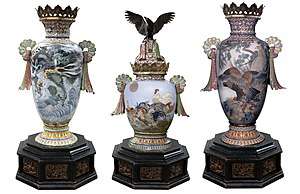Khalili Imperial Garniture
The Khalili Imperial Garniture is a trio of cloisonné vases created for a Japanese Imperial commission during the Meiji era.[1] The items were exhibited at the World's Columbian Exposition in Chicago, United States, in 1893, where they were described as "the largest examples of cloisonné enamel ever made".[2][3] After being exhibited, the vases were separated from each other for more than 120 years,[1] eventually reunited in 2019 in the private collection of the British-Iranian collector and scholar Nasser D. Khalili.[3]
| The Khalili Imperial Garniture | |
|---|---|
 | |
| Artist | Shirozayemon Suzuki, Seizayemon Tsunekawa, Araki Kanpo |
| Year | 1893 |
| Medium | Cloisonné enamel on copper |
| Dimensions | 172 cm (68 in) |
| Owner | Nasser Khalili |
| Accession | E10, EX439, EX512[1] |
Creation and exhibition
During Japan's Meiji era (1868 to 1912), the government actively promoted Japanese arts and crafts abroad by exhibiting the best examples in the world's fairs that were held in America and Europe.[4] Among the items exhibited at the World's Columbian Exposition was this garniture with a central incense burner.[2] The three vases are decorated with enamel and silver wire on a copper surface.[5] The eight feet, eight inches (264 cm) height quoted in the 1893 catalogue includes their wooden pedestals.[2] The height of the tall vases is 172 cm (five feet, eight inches).[2][5] The incense burner is topped by an eagle in bronze.[6]
A team of craftsmen, led by Shirozayemon Suzuki of Yokohama and Seizayemon Tsunekawa of Nagoya, took more than four years to construct the three items.[2] The painting was done by Nihonga artist Araki Kanpo (1831–1915), a member of the Japanese Imperial Household's art committee and of the Royal Society of Arts, London.[2]
Decoration and symbolism
The idea for the design is credited to "Mr. Shin Shiwoda, Special Counsellor for the Arts of the Japanese Commission for the World's Columbian Exposition".[2] The three vases depict a dragon, chickens, and eagles, respectively representing the virtues of wisdom, honesty and strength.[2] The imagery also has a geographical connotation, with the dragon representing China, the eagles Russia, a rising sun for Japan, chickens for the Korean Islands and the bronze eagle on the central censer representing the United States.[2] The general design also includes the four seasons of the year, with opposite sides of one vase showing autumn and winter scenes.[2] The neck of each vase features a striped red and white pattern with inlaid silver stars, reflecting that they were made to be shown in the United States.[2]
Collection
Among the eight collections assembled, published, and exhibited by London-based collector, scholar and philanthropist Nasser Khalili is a collection of Japanese decorative art of the Meiji era, considered to be only equalled by the collection of the Japanese imperial family.[3] Khalili acquired the first vase, depicting eagles, in Los Angeles in the early 1990s.[1] It formed part of a 1999 exhibition of Meiji art in Wilmington, Delaware.[2] The incense burner depicting chickens was in the collection of the Tokyo National Museum until bought by Khalili in 2000.[1] The other vase, depicting a dragon, was considered lost to the antiques trade.[3] In January 2019, it was discovered; it had been the centerpiece of the main dining room of Spenger's Fresh Fish Grotto in Berkeley, California,[7] one of the oldest restaurants in the San Francisco Bay area.[8] Frank Spenger, son of the restaurant's founder, had acquired the vase at the 1894 California Midwinter Fair.[8] On 17 February 2019, Khalili bought it for $110,000 at an auction of Spenger family items, thus reuniting the garniture after more than 120 years.[3][8]
Gallery
References
- "News | The Khalili Collections Reunites Landmark Imperial Japanese Garniture – Said to be The Largest Examples of Cloisonné Enamel Ever Made – After Over 120 Years". Khalili Collections. 2019-04-12. Retrieved 2020-04-03.
- Earle, Joe (1999). Splendors of Meiji : treasures of imperial Japan : masterpieces from the Khalili Collection. St. Petersburg, Fla.: Broughton International Inc. p. 234. ISBN 1-874780-13-7. OCLC 42476594.
- Arkell, Roland (1 March 2019). "Renowned collector Nasser Khalili revealed as buyer of 'lost' monumental Meiji vase as he reunites it with original set". Antiques Trade Gazette. ISSN 0306-1051. Retrieved 2020-04-03.
- Earle, Joe (1999). Splendors of Meiji : treasures of imperial Japan : masterpieces from the Khalili Collection. St. Petersburg, Fla.: Broughton International Inc. p. 10. ISBN 1874780137. OCLC 42476594.
- "Japanese Art of the Meiji Period | Vase". Khalili Collections. Retrieved 2020-04-03.
- "Japanese Art of the Meiji Period | Incense Burner". Khalili Collections. Retrieved 2020-04-03.
- Arkell, Roland (14 January 2019). "Monumental Meiji vase 'rediscovered' in a Californian restaurant comes to auction". Antiques Trade Gazette. ISSN 0306-1051. Retrieved 2020-04-03.
- Arkell, Roland (25 February 2019). "Huge 'lost' Meiji vase goes from seafood restaurant to saleroom". Antiques Trade Gazette. ISSN 0306-1051. Retrieved 2020-04-03.


